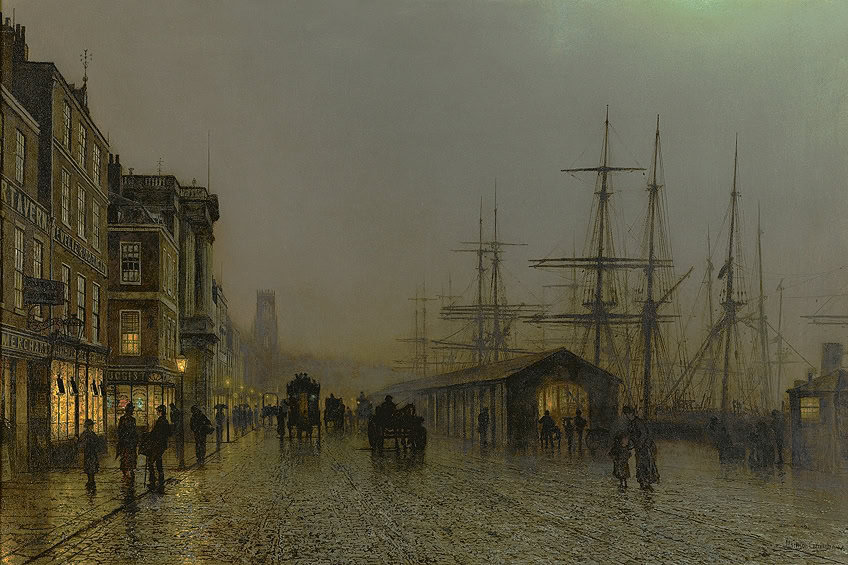John Atkinson Grimshaw – Victorian Nightlife in Art
John Atkinson Grimshaw was a distinguished British painter renowned for his evocative and atmospheric nightscapes and urban scenes. A self-taught artist, Grimshaw developed a unique style characterized by meticulous attention to detail and masterful use of light and shadow. His works often depict the streets and docks of Victorian cities, illuminated by moonlight or lamplight, creating a hauntingly beautiful and almost surreal ambiance. Grimshaw’s ability to capture the essence of the urban landscape and his innovative use of lighting techniques have earned him a lasting legacy in the world of art, celebrated for their emotive and ethereal qualities.
Key Takeaways
- John Atkinson Grimshaw was a self-taught Victorian-era artist recognized for his detailed night scenes of urban landscapes.
- He utilized emerging photographic techniques to add a lifelike quality to his paintings, distinguishing his work from that of his contemporaries.
- Grimshaw’s legacy continues to influence the appreciation of Victorian art and urban realism in contemporary culture.
Early Life and Career
| Birth | September 6, 1836 |
| Death | October 13, 1893 |
| Place of Birth | Leeds, United Kingdom |
| Genre of Work | Landscape and nocturnal art, and urban scenes |
John Atkinson Grimshaw was an influential English artist renowned for his ability to capture the essence of the Victorian era through his paintings. Grimshaw started his career as a railway clerk, but his love for art propelled him towards becoming a self-taught painter. His dedication to his craft was evident in the unique style that characterized his work, which often involved nocturnal scenes of city streets and dockyards. These paintings stood out for their remarkable detail and atmospheric effect, capturing the emotions of the Industrial Age with a distinctive blend of realism and romanticism.

Grimshaw’s artistic journey was one of innovation and exploration. He delved into the interplay of light and shadow, utilizing the then-emerging technology of photography to enhance the realism in his work. His meticulous night-time scenes featured moonlit paths, gas-lit streets, and tranquil twilight vistas, which were a departure from the pastoral landscapes commonly depicted by his contemporaries. With each brushstroke, he conveyed the quiet and often overlooked beauty of urban environments under the cover of darkness.
His approach not only resonated with the Victorian public but also left a lasting impression on the art world that extends to modern times.
Formative Years
Born on September 6, 1836, in Leeds, Grimshaw’s childhood was set against the backdrop of the rapidly industrializing English city. This environment would later serve as a canvas for his evocative paintings. Grimshaw was raised in a family where his father was a former policeman, which likely provided him with a structured upbringing.
Artistic Beginnings
Despite his initial career as a clerk for the Great Northern Railway, his passion for painting took precedence, compelling him to forsake a steady job for artistic pursuit. In 1858, Grimshaw married Frances Theodosia Hubbarde, and they welcomed a family that eventually included many children, some of whom would follow in their father’s footsteps as artists.

Mature Period
Grimshaw’s mature work gained recognition for its detailed treatment of light and atmosphere, particularly in night scenes, showcasing streets and dockyards of the Victorian era. His technique showed the influence of photography on his compositions, which were meticulously realistic with keen attention to illuminative effects.
Later Period and Death
In his later years, Grimshaw enjoyed friendship and admiration from other notable artists, including James McNeill Whistler. His work, once matured, seldom wavered from his chosen themes of urban life and landscapes under twilight or moonlit skies. John Atkinson Grimshaw passed away on October 13, 1893, leaving behind a legacy that had a lasting impact on Victorian art.

Artistic Style and Themes
John Atkinson Grimshaw’s artistic style is notably characterized by his poignant nocturnal urban landscapes, which reveal a skilled fusion of realism and atmospheric effect. His distinctive choice of themes and highly adept use of lighting set him apart as a notable painter of the Victorian era.
Techniques and Influence
Grimshaw demonstrated exceptional skill as a draughtsman and utilized the camera obscura to achieve accurate perspective in his work. His technique involved a meticulous approach to composition and colour, with a propensity for capturing the essence of nature and urbanity on canvas. Influenced by photography, his application of light and shadow imparted a realistic quality to his paintings, while also evoking strong emotional responses from viewers. His peer, James McNeill Whistler, acknowledged Grimshaw’s contribution by remarking that he believed himself to be the inventor of Nocturnes until he encountered Grimshaw’s moonlit pictures.

Urban Landscapes and Nocturnes
Grimshaw’s urban landscapes and nocturnes are particularly popular, featuring dimly lit streets, glistening pavements, and gas-lit cityscapes that convey a tranquil, yet vibrant, urban life. His adept handling of lighting techniques created nuanced moods and atmospheres which resonated with the reality of Victorian cities. Grimshaw’s capacity to capture the nocturnal urban scene made him both a pioneer and an inventor in this genre.
His art resonates with the quality of realism, often blurring the line between a recorded image and a painted one, thus showcasing his remarkable skill in rendering lifelike scenes combined with an undercurrent of subtle emotional depth.
Significant Works
John Atkinson Grimshaw’s body of work is notable for its atmospheric depictions of urban landscapes, particularly those showing cities under the ethereal light of the moon. He left behind a legacy as a prominent English painter of the Victorian era.

Notable Paintings
John Atkinson Grimshaw masterfully captured the essence of urban scenes at night, with his acclaimed works like On Hampstead Hill depicting the mesmerizing transition from twilight to darkness. His painting, Knostrop Old Hall, Leeds, illustrates his precise portrayal of historical architecture bathed in soft moonlight, showcasing his exceptional ability to blend atmospheric lighting with intricate detail.
Grimshaw’s seascapes and maritime subjects highlight his skillful use of light and shadow, with works like Scarborough capturing the ambiance of coastal towns.
His painting, The Castle by the Sea, stands out for its dramatic portrayal of the interaction between the natural and built environments, showcasing his exceptional ability to blend atmospheric lighting with intricate detail. Although best known for his urban scenes, Grimshaw also excelled in painting serene rural landscapes, as evidenced by works like Chelsea in Snow, which demonstrate his versatility and keen observation skills.
Contributions to Artistry
- Visual Realism: Grimshaw’s paintings reflect a meticulous focus on lighting and detail. His technique is sometimes connected with the realism brought about by the era’s interest in photography.
- Atmospheric effects: He is distinguished for the atmospheric quality of his paintings, conveying mood through meticulous light and color.

Public and Critical Reception
- Critical acclaim: Grimshaw’s artworks received a positive reception for their unique blend of realism and atmospheric mood. Victorian-era art critic and historian Christopher Wood acknowledged Grimshaw as a “remarkable and imaginative painter.”
- Public appeal: His depiction of both rural and urban Victorian Britain resonated with the public, who found familiarity and solace in his paintings. Today, Grimshaw’s artworks are highly prized and continue to capture the imagination of viewers with their timeless quality.
Legacy of John Atkinson Grimshaw Today
John Atkinson Grimshaw left an indelible impression on the art world with his townscapes and nocturnal scenes. Following his death on October 13, 1893, his legacy endured, experiencing a resurgence in the latter half of the 20th century. His work is marked by a distinctive capture of urban atmosphere, with a keen eye for light and shade, which has continued to resonate with audiences and artists alike. Grimshaw’s legacy lives on through his sons, who inherited their father’s artistic talents:
- Louis H. Grimshaw (1870 – 1944): Carried on his father’s style, focusing on urban landscapes.
- Wilfred Grimshaw (1871 – 1937): Also an artist, though not as widely recognized.

Elaine Grimshaw and Frances Hubbard, although less information is publicly available about them, were also part of his family, which upheld the Grimshaw name in artistic circles. Their creative pursuits ensured that Grimshaw’s influence would percolate through subsequent generations, and today his works are cherished for their unique portrayal of Victorian and Edwardian England. Exhibitions devoted to his paintings contribute to the continuing appreciation and understanding of his techniques and themes. John Atkinson Grimshaw’s legacy, therefore, remains prominently in the realms of art history and cultural scholarship, offering a window into the urban life of his time.
John Atkinson Grimshaw’s legacy endures as a testament to his extraordinary ability to transform the mundane into the magical through his masterful renderings of light and shadow. His atmospheric nightscapes, rich with detail and imbued with a haunting beauty, continue to captivate art enthusiasts and scholars alike. Grimshaw’s unique vision and technical prowess have secured his place in art history as a pioneering figure of Victorian urban landscape painting. His works remain celebrated not only for their aesthetic appeal but also for their ability to evoke the mystery and quietude of the nocturnal world, ensuring that Grimshaw’s name remains synonymous with the evocative power of the night.
Frequently Asked Questions
Where Can Original Paintings by John Atkinson Grimshaw Be Purchased?
Original paintings by John Atkinson Grimshaw come up for sale at major auction houses. Interested collectors should monitor these institutions for upcoming auctions. Private art dealers and galleries specializing in Victorian art also occasionally have Grimshaw’s pieces available.
Which Museums House Collections of John Atkinson Grimshaw’s Work?
Several museums in the United Kingdom house collections of Grimshaw’s work. Notable examples include Leeds Art Gallery in his birthplace, and the Tate Britain in London. Public institutions across the UK and abroad may have his paintings in their collection or on display.
What Techniques Are Characteristic of John Atkinson Grimshaw’s Painting Style?
Grimshaw’s painting style is characterized by remarkable attention to detail and moody lighting, often showcasing urban landscapes at dusk or in a nocturnal setting. He had an adept use of glazes and a keen understanding of the interplay between light and shadow, which contributed to the ethereal and realistic quality of his scenes.
Isabella studied at the University of Cape Town in South Africa and graduated with a Bachelor of Arts majoring in English Literature & Language and Psychology. Throughout her undergraduate years, she took Art History as an additional subject and absolutely loved it. Building on from her art history knowledge that began in high school, art has always been a particular area of fascination for her. From learning about artworks previously unknown to her, or sharpening her existing understanding of specific works, the ability to continue learning within this interesting sphere excites her greatly.
Her focal points of interest in art history encompass profiling specific artists and art movements, as it is these areas where she is able to really dig deep into the rich narrative of the art world. Additionally, she particularly enjoys exploring the different artistic styles of the 20th century, as well as the important impact that female artists have had on the development of art history.
Learn more about Isabella Meyer and the Art in Context Team.
Cite this Article
Isabella, Meyer, “John Atkinson Grimshaw – Victorian Nightlife in Art.” Art in Context. May 21, 2024. URL: https://artincontext.org/john-atkinson/
Meyer, I. (2024, 21 May). John Atkinson Grimshaw – Victorian Nightlife in Art. Art in Context. https://artincontext.org/john-atkinson/
Meyer, Isabella. “John Atkinson Grimshaw – Victorian Nightlife in Art.” Art in Context, May 21, 2024. https://artincontext.org/john-atkinson/.











